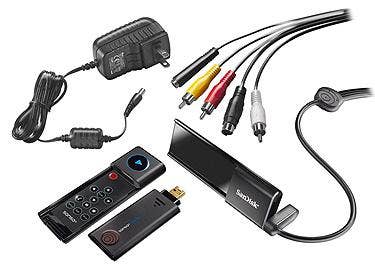SanDisk's Sansa TakeTV Challenges Apple TV
Daniel Amir, an analyst with Lazard Capital Markets, says SanDisk's entry into the PC-to-TV space is indicative of a nascent but growing market. "One of the major new markets for flash memory is portable video," he says. "In the future, that will be one of the biggest drivers of flash media." Amir says SanDisk is viewing Fanfare as a competitor to Apple TV, though the beta version only offers a handful of CBS television shows.
The benefit for SanDisk in helping push this market is the increasing requirements for flash drive space as the demand for portable video grows. "This whole service of downloading video from the Internet to your Sansa will create the fact that you'll need a lot more memory on your Sansa player," he says. "SanDisk looks at this and says, 'I'm helping create a market here, but it will require more and more flash storage. I'll create the market and be able to enjoy from it in the future.'"
The device consists of three components: A USB flash drive, a remote control, and a TV cradle which connects the drive to the television through the television's A/V or S-Video sockets. After plugging the USB drive into the computer, users drag and drop video files into the player, then plug the player into the cradle. On the television screen a menu pops up to guide the user, with the aid of the remote control, through the content.
Sansa TakeTV works with the Windows Vista and XP as well as the newest versions of Mac and Linux operating systems, and it supports MPEG-4, DivX, XVID video formats. SanDisk offers a 4GB and a 8GB version, priced at $99.99 and $149.99, respectively. It marks SanDisk's first product from the USBTV initiative the company announced at CES this year.
